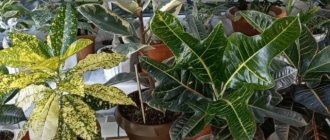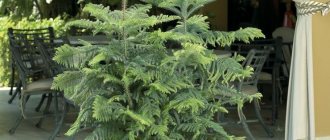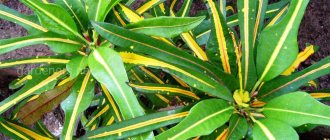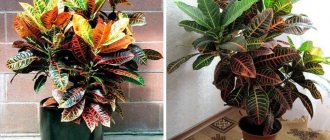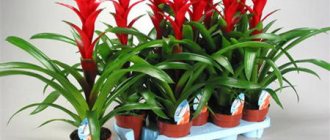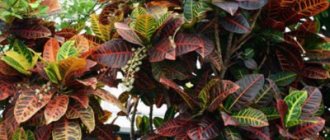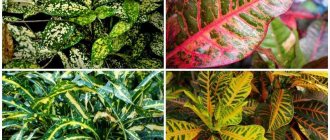Under natural conditions, this plant grows in Malaysia; it can also be seen in the eastern part of India.
In nature, there are 17 varieties of such crops, the height of individual specimens reaches 2.5 meters.
General information
The codiaum flower feels good when grown indoors. This plant has many varieties , each of which has its own leaf color. Codiaum Mix looks especially beautiful on the windowsill. The shades of the leaves of different varieties are different; the leaf blades of crops can be yellow, dark purple and even red . Pink spots are clearly visible on individual leaves.
It is quite difficult to obtain inflorescences from a crop when caring for it at home. If all growing conditions are met, codiaum blooms in the warm season, in summer.
Note! The inflorescences of the plant are small, almost invisible against the general background of foliage. Gardeners purchase this crop solely for the sake of its beautiful decorative leaves.
Popular varieties of croton
The most unusual and decorative varieties that do not require special attention and care at all stages of growth and development are especially popular among domestic amateur gardeners. It was from the most common species Codiaeum variegatum var.Pictum that breeders managed to obtain a large number of varieties and hybrids with various colors and leaf shapes.
Mrs Eyeston
It has dark green, oval-lanceolate leaves with cream markings or red and pink spots between the veins.
Excellent
It has large three-lobed foliage of light green color with yellow or bright red veins.
Codeum Excelent
Tamara
A popular croton variety among domestic gardeners, it has whitish-green leaves with an original pinnate shape.
Sleigh old
A potted plant with numerous side shoots and lanceolate leaves of bright green color.
Codeum Sani star
Types and varieties of codiaum
Breeders know about 17 varieties of the described plant, but at home they mainly grow variegated codiaum and its varieties . The classic species grows in the southeastern part of Asia in the tropical zone.
When developed in natural conditions, the plant has the appearance of a tree, its height reaches up to 4 meters. The leaves of the crop are leathery, up to 30 centimeters in length; the color of the leaf blades depends on the characteristics of the particular plant. Next, let's get acquainted with the most popular varieties of flowers.
- Codium Mammi differs from other varieties in its narrow and small leaf blades with wavy edges. The leaves curl along the central vein. The colors of greenery can be very diverse; on one plant there are leaves of red and green color with pink splashes and yellow veins.
- Croton Excelent has lobe-like leaves of green color and yellow veins. The inside of the leaves is red with brown veins.
- Codiaum Mrs. Iceton has broad but short leaves. The leaves of young crops are cream-colored; with age they become pink or red with numerous yellow spots. Some crops also have dark, almost black or yellow leaves.
- Croton Mix has many subspecies. The leaves of this crop with sharp edges are up to 20 centimeters in length. In some varieties, the size of the leaf blades reaches 30 centimeters.
- Codiaum Sunny Star is distinguished by green leaves with yellowish tips. The leaf blades are slightly pointed, lanceolate in shape. Young leaves on this plant have a greenish color with yellow spots and the same veins.
- Croton aucubifolia is widely used in indoor floriculture. The leaves of this plant have an uneven color with yellow and green tones. The leaf blades are quite narrow.
- Codiaum Tamara has feathery leaves with a combination of white and green shades.
- Codium Zanzibar can decorate any interior. This culture has narrow, long, lance-shaped leaves with curves. The leaf blades of Zanzibar are purple, yellow and green. Many gardeners choose this particular codiaum; caring for it at home is quite simple. This culture is quite beautiful, but rarely blooms.
- Croton Petra differs from other varieties in its lined shoots with large, veiny leaves in an alternate arrangement. The leaf blades on this plant often contrast. Moreover, most of the vegetative organs are olive in color with variegated yellow spots along the veins.
- Codium Gold Sun is a decorative indoor flower with beautiful variegated foliage. The variety needs sufficient lighting. The height of the plant does not exceed 30 centimeters.
Advice! Based on the given descriptions of species and varieties, you can select codiaum for growing indoors.
Trimming / Support / Garter
The easiest way to form a plant is throughout the year.
Codiaeum tends to grow a central stem, so to get a compact spherical bush, you should periodically pinch the apical bud.
Single-stemmed codiaums can be pruned at a height of 15 cm to encourage them to branch.
Pruning of adult plants is carried out for the purpose of rejuvenation, or to obtain planting material.
During spring pruning of an adult branched bush, it is necessary to remove dry and weak branches. Also, if there is a lack of light in winter, the shoots of the plant may stretch. All elongated ugly branches are cut off by 2/3. Strong and very long shoots should also be cut by half or 1/3.
A properly formed codiaum bush looks like a small lush tree. It does not need support or garter.
Caring for codiaum at home
According to experienced flower growers, caring for codiaum is not as difficult as it might seem at first glance. This shade-tolerant plant will not cause any trouble even for an inexperienced gardener. Next, we will look at all the nuances of care in more detail.
Lighting
It is recommended to place a pot with this flower on windowsills facing the eastern or western part of the world. It is not recommended to place such a plant on southern windows, because intense sunlight in this place can cause burns to its leaves.
Important! If there is a lack of sunny color, the leaves of the crop will lose their variegated color. The optimal lighting option is diffused light.
Temperature and humidity conditions
The temperature in the room when growing croton in the summer should be stable, corresponding to 20-25 degrees.
With the arrival of winter, the temperature can drop to 18 degrees, but not lower.
The culture does not tolerate exposure to drafts; codiaum sheds its leaves from cold air , so keep the flowerpot with the plant away from open windows and doors.
Despite the fact that Croton is a leaf succulent, it requires a humidity level of 70-75% . Such indicators can be achieved by regularly moistening the leaves of the plant. In addition, the leaves should be constantly wiped with a damp soft cloth or napkin . To increase the humidity level, place a container with water and expanded clay or pebbles next to the pot.
Watering
The indoor codiaum flower is watered as the top layer of soil dries. The amount of irrigation liquid should be moderate; if it is over-moistened, the crop will begin to shed its leaves.
To prevent stagnation of water, drainage from expanded clay is arranged at the bottom of the flowerpot. Watering the plant must be done with soft or pre-boiled water. You can also use pre-settled tap liquid.
This video talks about the Euphorbiaceae family and how to care for plants of this family, in particular croton:
Top dressing
During the growing season in spring and autumn, the plant must receive additional nutrients from the soil. Feeding is carried out every two weeks . To enrich the soil with useful substances, special water-soluble store-bought fertilizers are used. The working solution is prepared in accordance with the instructions on the package.
Transfer
A few days after purchase, indoor plants need to be transplanted into a new container.
During this procedure, you need to thoroughly clean the roots of the plant from the old nutrient substrate.
A new flowerpot is selected several centimeters larger in diameter than the transport container. Expanded clay drainage is placed at the bottom of the pot and special soil is poured on the base of leaf, turf and humus soil with the addition of sand and peat.
Note! Young crotons are replanted annually in the spring. Old plants are moved to new larger containers as the root system grows, but at least once every 2-3 years.
Care
Temperature
So, codiaum excelent! How to care? Let's start with the fact that a newcomer from the humid and hot wilds of Malaysia, the flower needs warmth, and feels best in the range of +21-25°C. It will withstand +18°C, but not lower - in cold soil its roots will quickly die.
For the winter, place it near the battery. Drafts are destructive for this sissy - as soon as it drops its leaves.
Light mode
This species truly loves the sun, especially its morning and evening rays - the more light, the brighter and more variegated its foliage; only in the hottest hours of summer days is openwork partial shade acceptable.
But you can leave the flower in the sun.
The main thing is not to spray it, otherwise the plant will get burns.
In winter, the codiaum should also receive as much light as possible.
Watering
In summer, codiaum craves moisture, so the soil in the pot should be kept moist (but not wet!). When watering, everything that is glass in the pan should be poured out immediately; excess moisture causes rotting of the roots.
You cannot take water for irrigation directly from the tap - it must stand for at least a day and warm up to at least room temperature. In winter, watering is reduced, but the earthen ball should not dry out.
Air humidity
Codiaum needs stagnant humidity, like in a tropical forest. You can create such a “bath” at home using a humidifier (especially in winter). Another convenient option is to place the flower on a “cushion” of wet pebbles.
Spray daily with soft warm water. And also wipe the leaves from above and below with a damp sponge. Once a month, give him “rain” in the shower, covering the soil with film.
Fertilizers
From May to October, codiaum grows very quickly, sometimes in spurts, throwing out 2-4 leaves.
At this time, he needs frequent feeding - once every 1-2 weeks.
The best option is liquid complex fertilizer such as Ideal, Oasis.
Water the plant before fertilizing.
In winter, growth is slower, and this beauty needs additional nutrition - once every 3-4 weeks.
The soil
Codiaum loves alkaline soil with a pH of 6.5–7.4. The soil for it is prepared on the basis of peat, humus and coarse sand, taken in equal parts, and is abundantly fertilized with humus.
Transplant (after purchase)
The purchased codiaum must be replanted from a store-bought substrate, having first thoroughly cleaned the roots. The pot for it should be slightly wider than the roots - it likes to grow in tight spaces.
Place more drainage at the bottom of the dish. Calcify the soil well so that all pests die. You can add charcoal to it, which prevents rotting of the roots.
In the first 3-4 years, the root system of codiaum grows rapidly. At this time, it needs to be replanted annually in the spring. An adult plant is rarely disturbed when the roots begin to protrude from the pot; the rest of the time they simply renew the top layer of soil.
Reproduction
Codiaum excelent is propagated at home in the spring by cuttings taken from the top of the plant.
Large shoots, 15 cm high, are selected, cut from the stem and placed in water to clean the sections from the poisonous milky juice.
This must be done with gloves. Then the cuttings need to be dried. To prevent them from losing too much moisture, the leaves can be rolled into a tube and secured.
The finished shoots are planted in pots with damp peat, covered with film and placed on a warm radiator. In this hot mini-greenhouse, the plants will take root within a month.
Theoretically, codiaum can also be propagated by seeds, but this method is mainly used by specialists when breeding hybrid varieties.
Trimming
To give the codiaum a beautiful shape, formative pruning can be done whenever there is a need. For him this procedure is not painful.
If the plant has become very elongated and has lost some of its leaves, in the spring the top should be cut off by 15 cm (this cutting can be rooted) and then the remaining “stump” will begin to branch.
The cut must be sprinkled with charcoal so that it does not leak juice. Also in the spring, young shoots are pinched - this makes the codiaum more magnificent. You need to wear gloves when pruning.
Bloom
If you properly care for this tropical sissy, it will bloom in the summer, but the small cream flowers do not differ in its beauty, and it takes a lot of energy from the plant.
So it’s better to cut them off right away.
Lifespan
Codiaum is a perennial plant; in the hands of an experienced gardener it can live for more than 10 years, but it is difficult for beginners to cope with, and the life of the plant is often limited to one season.
Reproduction
get new plants using cuttings throughout the year. To do this, the apical young or lignified shoot up to 10 centimeters in length is cut off from the mother bush. The milky juice is removed from the cut site and the wound is treated with crushed charcoal. After this, the cut site is treated with a root-forming composition and placed in a nutrient substrate.
The soil for codiaum should consist of peat and sand in equal volume parts. To quickly form roots, containers with cuttings are placed in a warm room with a temperature of 22-24 degrees. Caring for seedlings involves periodically watering the soil and spraying the plants.
An easier way to obtain new crops is
leaf propagation.
In this case, a large leaf is taken from the mother bush, the milky juice is collected from it and dipped in water, and the cut area is rubbed with charcoal.
Next, the leaf is rooted in a moistened nutrient substrate of peat and sand. The vegetative organ is placed under a film, periodically ventilated and moistened. After the seedling has several stems, it is moved to a separate pot.
Changing the adult and seating the children
After purchasing croton from a store, it is important to replant it as quickly as possible.
An adult plant is replanted once every 2-3 years. A young plant requires changing the soil every year. Cuttings with roots up to 5 cm in length require rooting in nutritious soil.
Substrate
The soil for croton needs to be loose and light, since the plant does not like moisture, but will not tolerate stagnation of water in the soil. The soil must be nutritious. A good combination can be obtained by mixing in equal parts:
- humus;
- turf land;
- leaf soil;
- sand
- peat.
A universal substrate will also work, to which you will need to add a third of sand. Before use, the soil must be treated with potassium permanganate and dried.
Important! For healthy flower development during transplantation, you need to change the drainage layer, make a new one at least 2 cm
Pot
Croton is one of those plants that, in a large pot, are busy growing roots until they cover its entire area. Therefore, the pot should be small, no matter how strange it may look in comparison with the size of the bush growing from it.
The size of the pot should freely accommodate all the roots of the flower + 1 cm of free space around for soil.
Clay and plastic pots are suitable for codiaum
It is important to have a drainage hole; stagnation of water is the cause of death.
It is important to know! It is better to transplant an adult flower in March using the transshipment method. After replanting, it is necessary to place the pot in a warm place, maintain humidity and watering regime
After transplanting, it is necessary to place the pot in a warm place, maintain humidity and watering.
Croton is difficult to tolerate transplantation, so during this period you need to provide it with as comfortable conditions as possible.
To the question of how to transplant a diseased croton, the answer is quite obvious. Experienced flower lovers advise curing it and then replanting it.
Diseases and pests, treatment, prevention
Codiaum, the photo of which indicates beautiful ornamental plants with variegated foliage, is rarely damaged by diseases and pests. This is mainly due to the fault of the gardener. For example, watering a crop with hard water can cause the tips of the leaves to turn yellow.
At the same time, exposure to direct sunlight causes burns to the leaves of the plant.
And a couple more nuances that you should pay attention to - when the temperature drops from the recommended values, the edges of the leaf plates become brown, and due to the influence of dry air, the surface of the leaves turns brown.
Note! The slowdown in plant development can be associated with a deficiency of nutrients in the soil. To restore the required amount of microelements, carry out extraordinary feeding.
Among the pests, codiaum is affected by scale insects, mealybugs, and spider mites. Under the influence of the last parasite, the leaves of the crop begin to turn brown. To prevent the appearance of the pest, constantly spray the plant with a spray bottle , which will maintain high humidity in the room. In case of strong spread of parasites, diseased crops are sprayed with Actellik, Karbofos or Fitoverm.
Plant morphology
A member of the Euphorbiaceae family, this shrub is a perennial species. An evergreen plant from the jungles of India and Malaysia is sometimes also called croton.
Important! The euphorbia family secretes a poisonous juice when the stem is broken or cut, which is especially dangerous for children and pets. When working with the plant, you must wear gloves.
Codiaum has the following characteristics:
- straight branching stem, in natural conditions - up to 3-4 m, in indoor conditions - 50-70 cm;
- length of leathery leaves up to 30 cm;
- the shape of the leaves is varied (linear, lanceolate, oval, etc.);
- variegated color, depending on the variety, yellow, green and red shades, with prominent veins;
- a dioecious plant produces female and male flowers collected in inflorescences;
- blooms rarely, female flowers have no petals, male flowers have a corolla and a calyx.
The plant has been known in Europe since the 19th century and was initially grown only in greenhouses, since it was considered to be demanding of high temperatures. Modern codiaums are represented by a variety of varieties that differ in the shape and color of the leaves. New varieties with curled leaves have appeared - “curly”. The plant gains the characteristic color and leaf contour of the variety with age.
- Having undergone careful selection, modern plants have the following advantages:
- much more hardy than traditional ones, and also less capricious;
- only a few leaves are lost in winter;
- quickly recover from missed watering.
The most popular varieties are:
- Petra - with thick veins in the center of the leaf and predominantly yellow-green color.
- Norma - a variety with hard, long dark green leaves, on which there are yellow spots and red veins.
- Sunny Star - is remembered for its beautiful narrow yellow-green leaves, decorated with a central yellow vein and golden border, as well as thin shoots.
- Gold Star - a narrow-leaved variety with rosettes of leaves resembling stars, painted with yellow specks.
Signs and superstitions
Among the people there are some signs and superstitions regarding the codiaum flower. According to psychics and traditional healers, this culture has colossal energy; it drives away bad people and energy vampires from the home, promotes the accumulation of positive emotions, and brings regularity and order to the living space .
Codieum helps indecisive people find themselves, improves the performance of the apartment owner, promotes creative development, and career advancement. Pessimists who grow the plant in question change their views on life and their personality. If a person did not believe in himself and his own abilities, then after some time from the moment of flowering, such people manifest rare talents and skills.
Croton will be an ideal gift for creative people . A culture growing on a windowsill adds prudence and sanity to all family members, regardless of their interests and field of activity. The energy of codiaum protects residents from committing rash acts.
How to choose the right codiaum variegated when purchasing
To buy a healthy plant, you need to carefully inspect it before purchasing. You need to pay attention to the following parameters:
- check the underside of the leaves for the presence of plaque or cobwebs, traces of pest bites;
- the leaves should be bright, with a natural shine;
- a bare trunk is undesirable;
- curled leaves (if this is not a sign of the variety) signal a disease.
After purchasing the codiaum, it is advisable to quarantine it, placing it away from other indoor plants.
Did you know? Codiaum is sometimes called "Joseph's cloak" due to the bright color of the foliage, reminiscent of the luxurious fabric from biblical tales.

